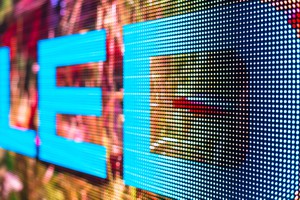
LED video walls are everywhere today. Some of the largest brands around the globe have incorporated LED video walls into their everyday marketing tactics, creating engaging campaigns that leave a lasting impact. In other situations, civic organizations, municipalities, churches, and schools are using LED video walls in unique and innovative ways.
What is LED Technology?
LED stands for light-emitting diode, which is a semiconductor device that creates visible light when electrical currents pass through it. The technology behind these tiny devices - which are usually less than 1mm - is complicated. In short, a current is applied to the diodes, which, in turn, enables electrons to combine with electron holes and release energy in the form of photons. All this scientific language translates into one thing: LED lights are more useful than their incandescent counterparts. LED lights have a longer lifespan, are more robust, come in smaller sizes, and switch faster.
LED Video Walls and Energy Efficiency
Your budget can dictate a lot of the elements you select when customizing a video wall for your organization. While thinking about your budget, you should consider the long-term operating and maintenance costs of your video wall in addition to the costs associated with buying and installing the wall. Luckily, LED video walls are extremely energy efficient, so you can look forward to reduced energy costs compared to a range of other types of signage.
LED Video Walls: Breaking Down the Concept
LED video walls are comprised of several individual LED modules that work together to showcase a fluid display. LED video walls are incredibly effective because each individual diode is responsible for its conducting and emitting its own light.
Small Pixel Pitch: Bigger Isn't Always Better
Pixel pitch is the phrase used to explain the density of pixels on an LED video wall. Pixel pitch indicates the amount of space between two pixels. In the case of LED video walls, each individual LED equates to a single pixel, and the smaller the pixel pitch, the clearer the image.
In other words, the less space between each diode, the less blurriness will occur on your video wall. Reason being, diodes that are placed closely together will offer a continuance of light from one element to another, ensuring your image or message has continuity from diode to diode. This rule applies in situations where you are dealing with the same size LED screen, but you are decreasing pixel pitch to bring the diodes closer together.
As pixel pitch gets tighter or smaller, you can use an increasingly smaller screen without compromising the clarity of your image. Additionally, as pixel pitch decreases, so too does the minimal viewing distance. In other words, with high pixel pitches, people need to stand further away to see the image clearly than they do with low pixel pitches. There is a direct relationship between pixel pitch, viewing distance, and screen size.
Additional Resource:
Indoor LED SignsBigger Isn’t Always Better: The Case for Small LED Signs
9 Futuristic Uses for Digital Signs and LED Wall Signs
How LED Video Walls Differ from Billboards or Traditional Signs
Once upon a time, static billboards were the premier way to reach large audiences. Now, LED billboards have begun to outperform their static counterparts for digital out of home advertising. This is happening for the following reasons.
- Content Flexibility. Traditional signs and static billboards don't allow you to change your message at a moment's notice. LED billboards, on the other hand, are completely digital, enabling you to switch up your content based on the needs of your audience.
- Compelling Changes. Static signage is costly and time consuming to change, meaning its messages are swapped out infrequently. Not only do advertisements often become irrelevant and outdated before companies go through the effort of updating traditional signage, but consumers quickly learn to ignore signs that stays the same day in and day out as they just become a part of the landscape.
- Interactivity. Static signs are just that – static. LED billboards incorporate technology that enables you to provide your audience with interactive experiences that leave lasting brand impressions, unlike anything the signage industry has ever had access to. Marketers are rolling out unconventional campaigns that embrace the interactive abilities of video walls.
- Brilliant, Captivating Colors. LED billboards are designed to continue captivating audiences with stunning colors and enticing hues for many years.
- Flexible Software. LED billboards operate via software that can easily be adjusted to accommodate various times of day, and other specific situations without losing the illuminating beauty they bring to their organizations.
Improved Return on Objective
When you opt for a video wall over a static billboard, you also have the ability to improve your return on investment or your return on objective. You get the chance to heighten engagement, plug more sponsors, and showcase more content. Ultimately, the upfront investment for a video wall brings increased value to your organization in several ways that you can measure in a variety of ways.
Comparing LED & LCD Displays
Not too long ago, there really wasn't much of a debate between LCD (liquid crystal displays) and LED; LCD always won hands down. LED technology has come a long way, however, and today's video walls are overwhelmingly powered by LED lights.
One major reason LCD outperformed its LED competitor two decades ago or so was cost; when LED lights and energy were still very expensive, LCD was the obvious choice for many budget-conscious organizations. As the cost of LED technology has become dramatically more affordable and the quality of products have increased, it's also become the top choice for video walls.
Indoor Video Walls for All Kinds of Businesses and Organizations
LED video walls offer a wide range of possibilities for businesses and nonprofit organizations such as schools, churches, civic groups, municipalities, and other groups. When choosing a video wall for your organization, you need to think about your content goals, budget, space, and how you want to use the video wall. Ultimately, these considerations are slightly different depending on the type of organization you run.
Video Walls as Electronic Scoreboards
In schools and professional sports stadiums, video walls can heighten engagement, show video replays, advertise sponsors, and accomplish a variety of other objectives. In this environment, video walls can also act as electronic scoreboards, providing increased flexibility and more advanced scorekeeping capabilities than traditional scoreboards.
Additional Resource:
Why LED Scoreboards Outperform Their CompetitionWhy Indoor Signage Is Important for Your School
7 Areas in Your School That Can Benefit from LED Video Walls
LED Video Wall Scoreboards in Schools
LED Video Walls as Electronic Scoreboards
How Much Does an LED Video Wall Cost?
There's a great deal that goes into factoring the cost of an LED wall. Size, placement, installation, and connectivity are all considerations for an LED video wall price. To get an accurate estimate of what your video wall may cost, it's important to learn about the various factors that may affect the overall price of the project and to discuss your needs with an LED sign company that works with organizations like yours.
Selecting the Right LED Video Wall Vendor
All LED sign companies are not created equal! Here are a few questions you should ask your potential vendor before you sign up for an LED video wall:
- How long have you been in business?
- Can you provide references and examples of your work?
- Why should I choose you over your competitors?
- What makes your approach to LED video walls different from other companies?
Don't be afraid to ask questions! The right vendor will happily provide plenty of information to reinforce your decision.
